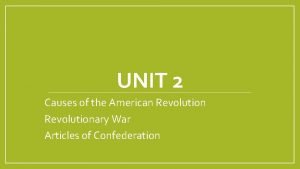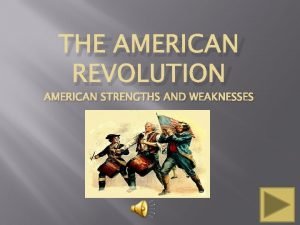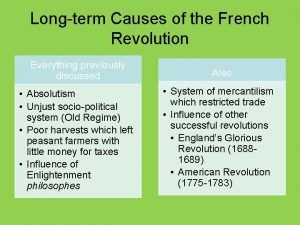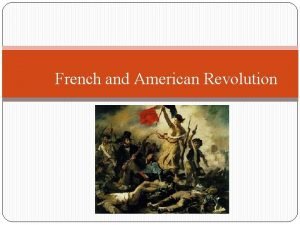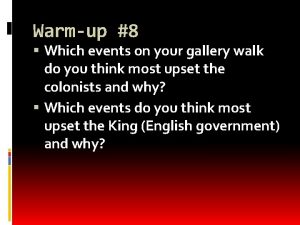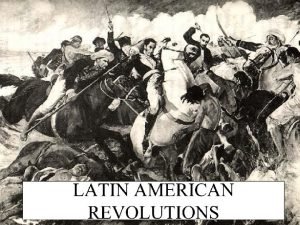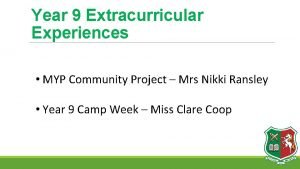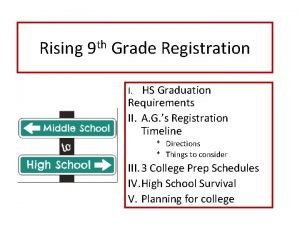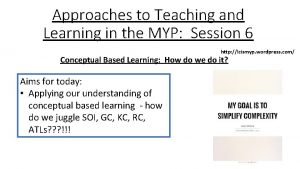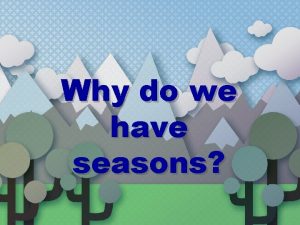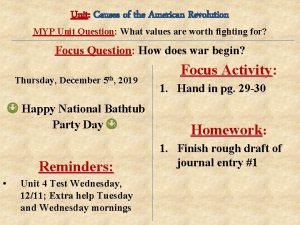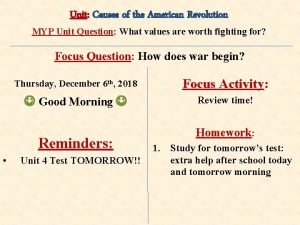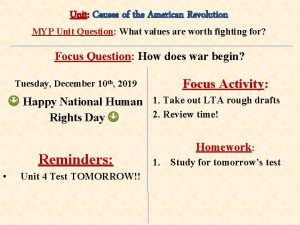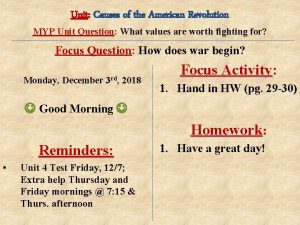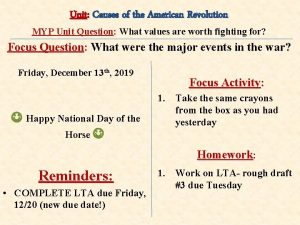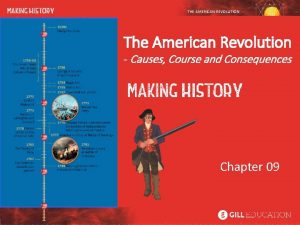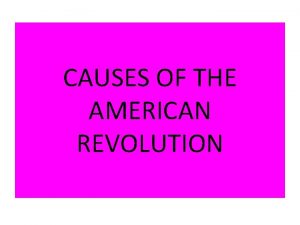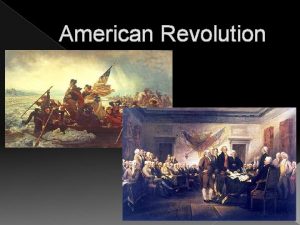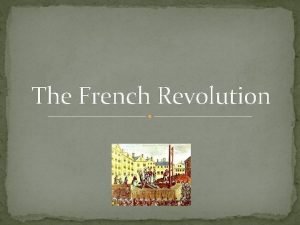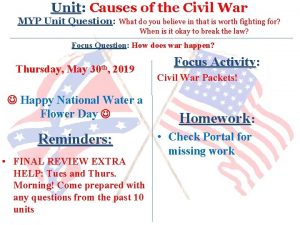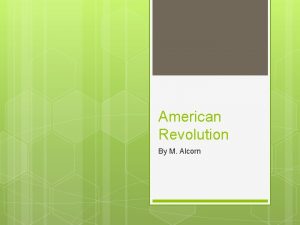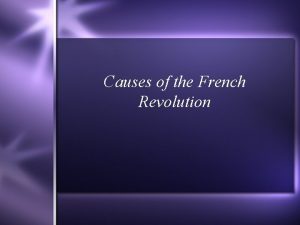Unit Causes of the American Revolution MYP Unit







![How did the Sons of Liberty Protest? • They boycotted [stopped buying] certain goods How did the Sons of Liberty Protest? • They boycotted [stopped buying] certain goods](https://slidetodoc.com/presentation_image_h2/5b92741e5c2fd6a2bd0d7cf904f89067/image-8.jpg)

![How did the Sons of Liberty Protest? • They hung effigies [fake hangings] from How did the Sons of Liberty Protest? • They hung effigies [fake hangings] from](https://slidetodoc.com/presentation_image_h2/5b92741e5c2fd6a2bd0d7cf904f89067/image-10.jpg)


















- Slides: 28

Unit: Causes of the American Revolution MYP Unit Question: What values are worth fighting for? Focus Question: Who were the Sons of Liberty? Tuesday, November 27 th, 2018 Hello! Reminders: • Unit 4 Test: Friday, 12/7 Focus Activity: 1. Hand in HW (pg. 14) 2. Complete page 15 Homework: 1. Check-in: pg. 19


Since the colonists were not represented in Parliament, many did not think they should have to pay taxes created by Parliament. Today, we elect representatives to Congress to make decisions for us- a representative government!

Boston (Massachusetts) in the 1770 s: The Sons of Liberty were protesting How did it get to this point? taxes!

The Sons of m a S : y t r e b i L Adams, John l u a P , k c o c n a H Revere. What risks a assoc r iated e with being a mem of the b Sons o er Libert f y?


How did the Sons of Liberty Protest? They made petitions for the colonists to sign against taxes.
![How did the Sons of Liberty Protest They boycotted stopped buying certain goods How did the Sons of Liberty Protest? • They boycotted [stopped buying] certain goods](https://slidetodoc.com/presentation_image_h2/5b92741e5c2fd6a2bd0d7cf904f89067/image-8.jpg)
How did the Sons of Liberty Protest? • They boycotted [stopped buying] certain goods to prevent the British from making money

How did the Sons of Liberty Protest? • They tarred and feathered Loyalists and tax collectors to embarrass them
![How did the Sons of Liberty Protest They hung effigies fake hangings from How did the Sons of Liberty Protest? • They hung effigies [fake hangings] from](https://slidetodoc.com/presentation_image_h2/5b92741e5c2fd6a2bd0d7cf904f89067/image-10.jpg)
How did the Sons of Liberty Protest? • They hung effigies [fake hangings] from trees to threaten and scare Loyalists and British officials

How Well Do You Know…

1. TRUE: The Sons of Liberty were originally known as The Loyal Nine, composed of elite gentleman, mainly law men and artisans, who met discretely to begin to organize against the actions of the crown. The Loyal Nine were responsible for putting boundaries on the violence of Boston, and set limits on how far the rebellions should progress.

2. FALSE: Sam Adams and John Adams were second cousins.

3. FALSE: Adams was a failed businessman, a newspaper editor, and (ironically), a tax collector (he was not very good at this job). In the 1760 s, he became more involved with the government and eventually became a statesman and governor of Massachusetts.

4. TRUE: Sam Adams was never known to speak very highly about money. According to a historian, Sam Adams was "a man utterly uninterested in either making or possessing money". He had other priorities, like leading the Sons of Liberty!

5. TRUE: Though Benedict Arnold is now known as a traitor for leaving the Patriots and joining the British in the Revolutionary War, he did begin his career as a Patriot in the Sons of Liberty.

6. TRUE: John Hancock was a wealthy shipping merchant (in charge of trade) who was very close with the Massachusetts governor in the 1760 s. The governor actually turned to Hancock for help when Sam Adams began to cause trouble. It was not until after the Intolerable Acts were passed, directly affecting Hancock’s business, that he turned Patriot and joined the Sons of Liberty.

7. FALSE: Despite popular historical accounts, Revere never rode hundreds of miles through New England shouting "the British are coming. ” He did ride to Lexington to alert the militia of the movement of the British troops and to warn John Hancock and Samuel Adams of their arrest if caught, but he actually did most of these acts in secret. In public, he was a well -known Patriot.

8. TRUE: Though the Sons of Liberty DID gather in meetinghouses, they also had one tree, named the Liberty Tree, that became a symbol of patriotism and the Revolutionary cause. They would hang effigies from the tree, protest at the tree, and even take a lap around the tree when in the midst of an activity.

How Well Do You Know…

1. TRUE: Both composed music for Franklin’s armonica, a simple instrument that was played by touching the edge of spinning glass with dampened fingers.

2. TRUE: Franklin showed that it is possible to drive lightning’s electrical charge into the ground when he carried out his famous kite experiment. Franklin was safe in a shed when he attracted lightning with a key tied to a kite.

3. FALSE: He was right-handed. The confusion started when he wrote a skit about unequal treatment and signed it, “The Left Hand. ”

4. FALSE: Evidence suggests young Franklin was against killing animals for food. He also figured vegetables cost less than meat, so he could spend more of his earnings on books. His diet wasn’t completely free of meat and fish, though.

5. TRUE: Franklin, a champion swimmer who often swam a few miles in the Thames River when he lived in London, made basic wooden floatation devices to help others learn to swim. He also windsurfed on the pond at Boston Commons, holding a kite upward to propel himself across the water.

6. FALSE: Early Philadelphia firemen wore whatever they had handy.

7. TRUE: It is still being purchased today. The Franklin stove was the most efficient stove in the world when Franklin started selling it in 1742.

8. TRUE: The Franklinia alatamaha, a flowering shrub, has white flowers in the summer and early autumn and a beautiful display of purple in late autumn.
 10 causes of the american revolution
10 causes of the american revolution American revolution strengths and weaknesses
American revolution strengths and weaknesses American revolution causes and effects
American revolution causes and effects Outcome of french revolution
Outcome of french revolution Causes of the american revolution gallery walk
Causes of the american revolution gallery walk Latin revolution causes
Latin revolution causes Did american revolution cause french revolution
Did american revolution cause french revolution Myp planning
Myp planning Myp classroom
Myp classroom Atl skills report card comments
Atl skills report card comments Myp essay format
Myp essay format Task specific clarification myp
Task specific clarification myp Myp
Myp Myp science criterion c
Myp science criterion c Myp logo
Myp logo Myp
Myp Myp
Myp Managebac platon
Managebac platon Proximate and ultimate causes of behaviour
Proximate and ultimate causes of behaviour Ultimate and proximate causes of behaviour
Ultimate and proximate causes of behaviour Why do we have seaosns
Why do we have seaosns Causes and effects of the russian revolution
Causes and effects of the russian revolution French revolution causes and effects
French revolution causes and effects Committee of public safety
Committee of public safety Economic causes of the french revolution
Economic causes of the french revolution Short term causes of the french revolution
Short term causes of the french revolution Causes and effects of the french revolution
Causes and effects of the french revolution Political causes for french revolution
Political causes for french revolution French revolution causes
French revolution causes
